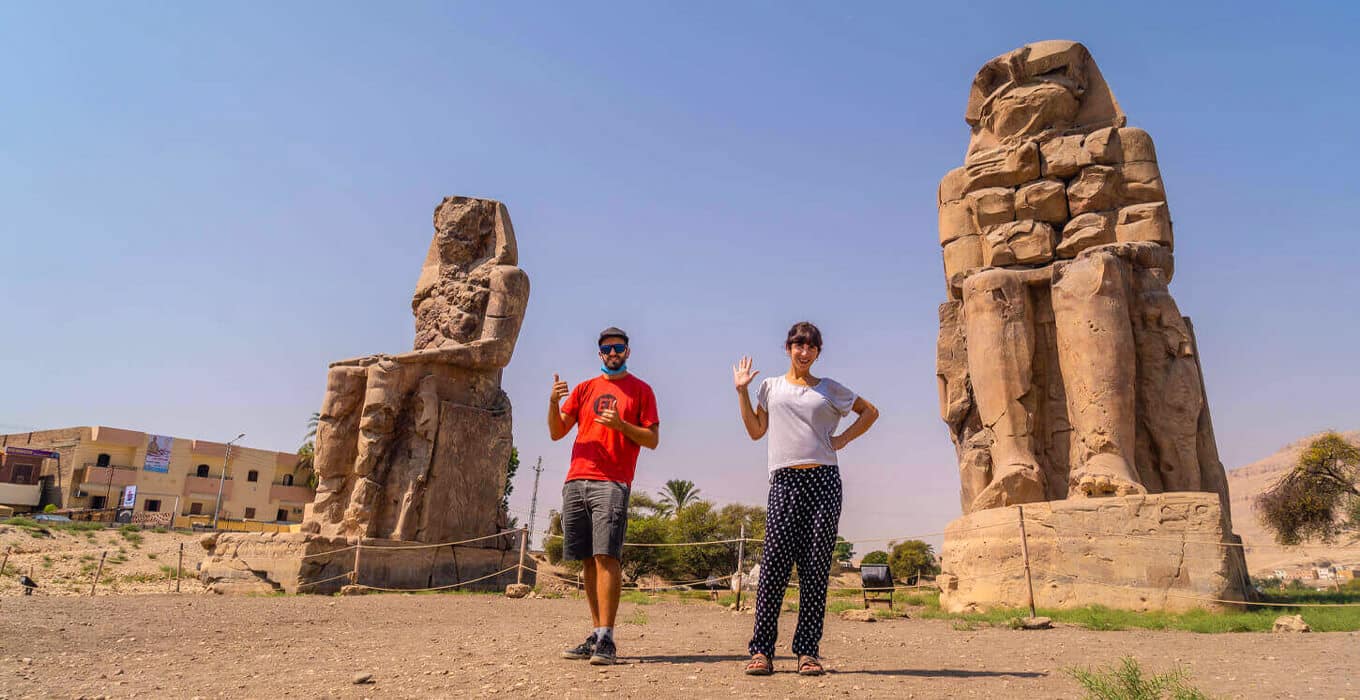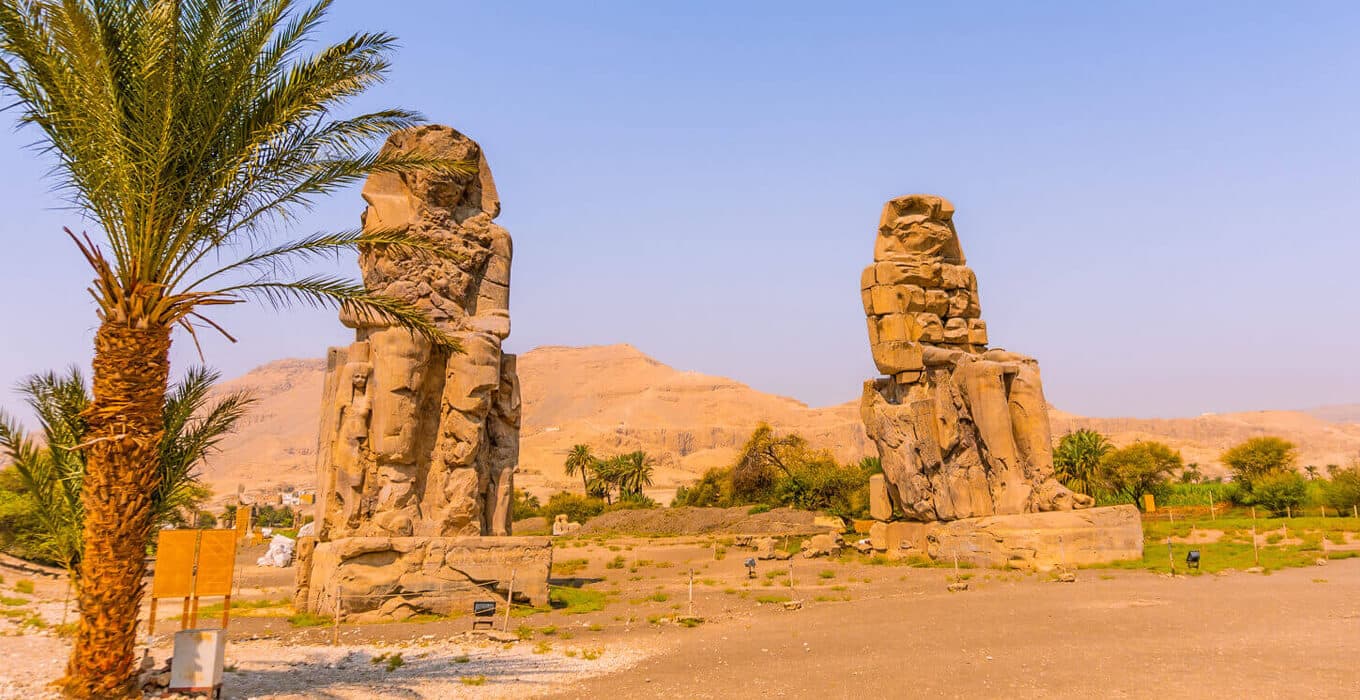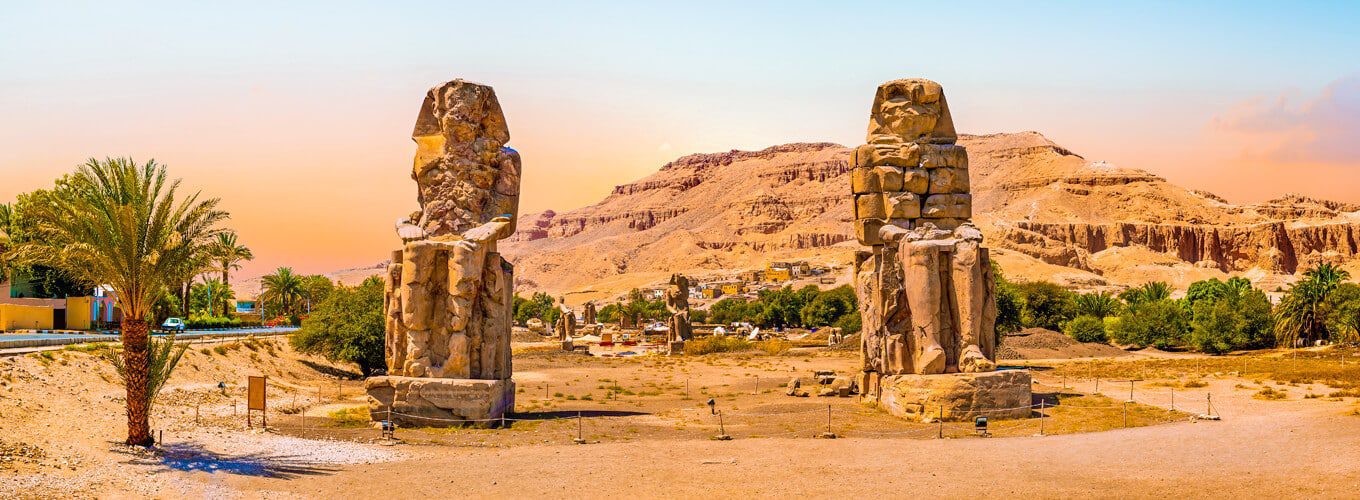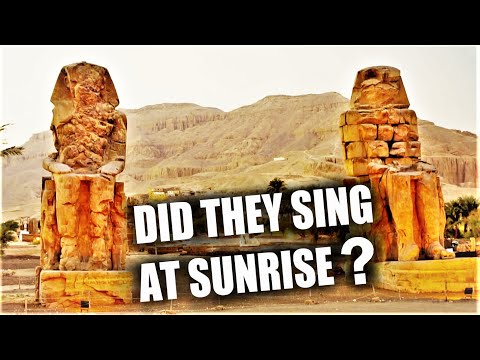The Colossi of Memnon have stood in Luxor, Egypt since 1350 BC. They show the greatness of ancient Egyptian architecture and art. These huge statues, weighing about 720 tons each, are 60 feet tall. They have lasted over 3,400 years, making them some of the oldest and most amazing monuments.
They are at the entrance of the ruined Mortuary Temple of Amenhotep III. This is the biggest temple in the Theban Necropolis. The statues show Pharaoh Amenhotep III with his wife Tiye and mother Mutemwiya. They are carved into the throne.
The Colossi of Memnon show the amazing skills of ancient Egypt. They highlight the engineering and art of a civilization that changed the world.
Key Takeaways
- The Colossi of Memnon are two huge stone statues of Pharaoh Amenhotep III, at the entrance of the Mortuary Temple in Luxor, Egypt.
- These statues, 60 feet tall and about 720 tons each, have lasted over 3,400 years in the desert.
- They are a great example of ancient Egyptian engineering and art. They show the power and beauty of the Pharaonic era.
- Visitors from ancient Greeks and Romans to today’s tourists love these statues. They are a key part of Egypt’s cultural heritage.
- The Colossi of Memnon are in the Theban Necropolis, a UNESCO World Heritage Site. This site also includes the Valley of the Kings and the Luxor Temple.
Introduction to the Colossi of Memnon
The Colossi of Memnon are famous ancient Egyptian statues from the 14th century BC. They were part of a huge temple, the “House of Millions of Years.” This temple was very big and fancy. Now, the Colossi stand as symbols of ancient Egypt’s skill in building and art.
Overview of the Colossi’s Historical Significance
Amenhotep III, who started as a young pharaoh, built the Colossi. They show the pharaoh sitting on a throne, looking east. His wife Tiye and mother Mutemwiya sit by his legs. The statues also have the Nile god Hapi on the sides.
Description of the Massive Stone Statues
The Colossi are huge, standing 18 m tall and weighing 720 tons each. They are made of quartzite sandstone from el-Gabal el-Ahmar. The statues and their bases are 18 meters high and 1,300 tons heavy. The granite for the statues came from near Cairo, 675 km from Luxor.

|
Statue Dimensions |
Detailed Measurements |
|
Height |
14 meters (46 feet) |
|
Weight |
700 tons each |
|
Pedestal Height |
4 meters (13 feet) |
|
Pedestal Weight |
600 tons each |
|
Total Height |
18 meters (60 feet) |
|
Total Weight |
1,300 tons each |
There are three more pairs of similar statues in Luxor, 11 to 15 meters tall. The Colossi of Memnon were 14 meters high, weighing 700 tons each. They sat on pedestals that were 4 meters high and weighed 600 tons each.
Architectural Marvels of Ancient Egypt
The ancient Egyptians were known for their amazing engineering and architecture. The Colossi of Memnon show this well. These huge statues are 18 meters tall and made from quartzite sandstone. This stone is reddish-brown and strong.
They were moved 675 km overland to the Theban Necropolis. This shows the big plans of Amenhotep III.
Construction Details and Quartzite Sandstone Material
The Colossi statues show the skill of ancient Egyptian craftsmen. They used quartzite sandstone, a strong and beautiful stone. This stone was chosen for its reddish-brown color and strength.
The making and moving of these statues show the ancient Egyptians’ engineering skills. They could quarry, transport, and build such big figures.
Connection to the Mortuary Temple of Amenhotep III
The Colossi were part of a big temple built by Amenhotep III. This temple was huge, covering 35 hectares. It was one of Egypt’s biggest and most beautiful temples.
Now, the Colossi stand as symbols of Amenhotep III’s legacy. They remind us of ancient Egyptian architecture and their beliefs.
|
Ancient Egyptian Architectural Wonders |
Key Details |
|
The Great Pyramid of Giza |
Built by Pharaoh Khufu, it rises to a height of 479 feet with a base of 754 feet and is made of over two million blocks of stone. |
|
Karnak Temple Complex |
One of the world’s largest temple complexes, it contains the Hypostyle Hall with 134 massive columns arranged in sixteen rows. |
|
Abu Sibel Temple Complex |
Features the Great Temple standing 98 feet high and 115 feet long, with four seated colossi that are each 65 feet tall. |
|
Luxor Temple |
Dedicated to the god Amun, it was built in 1400 BC by the New Kingdom and houses giant statues of Pharaoh Ramesses and two granite obelisks. |
Colossi of Memnon in Luxor, Egypt
Location and Accessibility in the Theban Necropolis
The Colossi of Memnon are two huge stone statues of Pharaoh Amenhotep III. They sit on the west bank of the Nile River, opposite Luxor in southern Egypt. These statues are in the Theban Necropolis, a big place for ancient Egyptian tombs and temples.
These statues are big but easy to see for visitors. There’s a lot of help for tourists, like parking and paths. They’re close to other big places in Luxor, like the Valley of the Kings and Karnak Temple.
|
Statue Dimensions |
Statue Weight |
Construction Period |
|
18 meters (59 feet) high |
720 tonnes (792 tons) |
Around 1350 B.C. (18th Dynasty) |
The statues show Pharaoh Amenhotep III, his wife Tiye, and his mother Mutemwiya. They were once part of six statues in Amenhotep III’s temple complex. Now, they still amaze people from all over the world. They show the amazing skills of ancient Egyptian builders.
Roman-Era Inscriptions and Mythology
The Colossi of Memnon in Luxor, Egypt, have always caught the eye of both ancient and modern people. They have over 100 Roman-era inscriptions in Greek and Latin. These inscriptions talk about King Memnon, a figure from Greek myths. This is why they are called the “Colossi of Memnon.”
Scholars think the northern colossus is linked to Memnon, a hero of the Trojan War. This connection comes from the Greek name for the Theban Necropolis, the “Memnonium.” These inscriptions helped early travelers and Egyptologists understand the statues’ link to ancient Greece and Rome.
Greek and Latin Inscriptions Mentioning King Memnon
The Colossi of Memnon have 107 Greek and Latin inscriptions. These were written by many people, like military officers, their families, and children. These inscriptions show us the different views and experiences of those who saw the colossi. They also show how much people were drawn to King Memnon’s story.
- Most inscriptions are from the Roman era. Eight prefects of Egypt wrote them, showing how important the site was back then.
- Many inscriptions have poems in an artificial Aeolic dialect. This shows how much people liked the statues’ literary and linguistic side.
- Visitors like the Roman poet Julia Balbilla left inscriptions. They give us a peek into what it was like to see the statues “sing” after an earthquake in 27 BCE.
These Roman-era inscriptions tie the Colossi of Memnon to ancient Greece and Rome’s rich myths and culture. They also show why this site is still so fascinating today.

The Phenomenon of the “Singing” Statues
The Colossi of Memnon in Luxor, Egypt, are famous for a cool sound. The northern statue made a musical sound when hit by the sun’s rays every morning. This sound was likely from temperature or humidity changes making the stone vibrate.
People came from far to hear the “Vocal Memnon.” Even Roman emperors visited to see the statues and hear the sound. The statues were linked to Memnon and his mom Eos, the dawn goddess, from Homer’s “Iliad.” The sound was high-pitched and only happened on some days at dawn, making it even more magical.
Many have tried to figure out why the statues made the sound. But, it stopped after repairs in the early 3rd century AD by Emperor Septimius Severus. This meant the special sound was lost.
|
Fact |
Details |
|
Construction |
The Colossi of Memnon were originally built in the 14th century B.C.E. as part of a mortuary temple for Egyptian ruler Amenhotep III. |
|
Material |
The statues are made of quartzite stone and are located in what is now Luxor, Egypt, previously known as Thebes. |
|
Singing Phenomenon |
The singing-like noises were associated with a rise in heat and humidity interacting with a cracked stone in one of the statues, and occurred after an earthquake destroyed part of one of the statues in 27 B.C.E. |
|
Visitor Attraction |
The phenomenon of the “singing” Colossi of Memnon attracted many tourists interested in hearing the alleged wails of Eos, the goddess of dawn. |
|
Cessation of Singing |
The singing ceased to occur after repairs were made by Roman Emperor Septimius Severus in the first or second century. |
The Colossi of Memnon show ancient Egyptian skill and our love for the mysterious. They remind us of the amazing things ancient people could do.
Damage and Reconstruction Over the Centuries
The Colossi of Memnon have faced a lot of damage and repair over thousands of years. They were built during the 18th Dynasty of ancient Egypt. Then, an earthquake around 1200 BC destroyed the bigger Mortuary Temple, leaving only the statues.
Later, in 27 BC, another earthquake hit, breaking the northern colossus from the waist down. The lower half of this statue started making a “singing” sound. This sound lasted until the 3rd century AD, when Romans tried to fix the statues by adding more sandstone.
But, they never found the statues’ original tops. These damage and repair times show how tough the Colossi are. They also show our efforts to keep this amazing ancient Egyptian legacy alive.
- The Colossi of Memnon stand approximately 18 meters (60 feet) tall and weigh around 720 tons each.
- The monuments have endured for over 3,400 years.
- The statues were damaged by a series of earthquakes over the centuries.
- The mortuary temple of Amenhotep III collapsed during the Roman period due to earthquake damage.
Despite the challenges, the Colossi of Memnon still stand as proof of ancient Egyptian engineering skill. They also show our ongoing efforts to save this historical treasure.
Cultural Significance and Tourism
The Colossi of Memnon have amazed people from all over the world. They show the greatness and beauty of ancient Egyptian culture. These huge statues, over 18 meters tall, were made by Pharaoh Amenhotep III around 3,400 years ago.
They were made from quartzite sandstone brought from a quarry 675 kilometers away. Their huge size and beautiful details have made them famous for centuries.
Being a UNESCO World Heritage site, they show the amazing skills of ancient times. Now, they are a big draw in Luxor, attracting many tourists every year. The northern statue is a bit bigger and looks even better than the southern one.
|
Statistic |
Value |
|
Height of the Colossi |
Over 18 meters tall |
|
Pharaoh Amenhotep III’s Reign |
14th century BCE |
|
Quarry Distance |
675 kilometers away |
|
Statue Material |
Quartzite sandstone |
|
UNESCO World Heritage Site |
Yes |
|
Annual Visitor Numbers |
Thousands |
The Colossi of Memnon still amaze people today. They connect us to the grandeur of ancient Egypt. These statues show the amazing skills of this ancient civilization.
Nearby Ancient Egyptian Attractions
The Colossi of Memnon are in the Theban Necropolis, a place full of ancient Egyptian sites. They are close to many attractions that show the power and beliefs of ancient Egypt.
Valley of the Kings and Valley of the Queens
Close by, the Valley of the Kings and Valley of the Queens have many pharaohs’ tombs. This includes the famous tomb of Tutankhamun. These places show us the beliefs and funerals of ancient Egypt.
Luxor Temple
The Luxor Temple is a big honor to the god Amun-Ra. It shows the skill and faith of the ancient Egyptians. Visitors can see huge obelisks and detailed carvings, showing the spiritual importance of these places.
Karnak Temple Complex
Not far from the Colossi, the Karnak Temple Complex is the biggest ancient religious site. It has many temples, obelisks, and sanctuaries. This place helps visitors understand the ancient Egyptian priesthood and their role in society.
These sites in the Theban Necropolis give a deep look into ancient Egypt’s history, art, and culture. For anyone visiting Luxor, these places are a must-see. They will surely make a big impression.
Visiting the Colossi of Memnon
The Colossi of Memnon are ancient statues in Luxor, Egypt. They welcome visitors all year. The site is open from 8 AM to 5 PM every day, but closes at 1 PM on Fridays for religious reasons.
People can see these huge statues and learn about their history. They are made of quartzite sandstone.
Best Times to Visit
The best times to see the Colossi are early morning or late afternoon. These times have fewer people and better light for photos. The statues look amazing when the sun makes shadows on them.
Admission and Accessibility
Seeing the Colossi is free, but you might need a ticket for the Valley of the Kings or other places in Luxor. There are guided tours for a deeper look at the area.
The site is easy to get to, on the West Bank of the Nile River in Luxor. You can get there by taxi, bus, or a tour.
Conclusion
The Colossi of Memnon show the amazing skill of ancient Egypt. These huge statues, from the 14th century BC, have seen earthquakes, wars, and time. They are now a key sight in Luxor.
They are all that’s left of the big temple of Amenhotep III. The Colossi take us back to the greatness of ancient Egypt. They amaze us with their size, details, and the mystery of their “singing” sound.
Visiting the Colossi of Memnon is an experience you won’t forget. It’s a chance to see the amazing work of the ancient Egyptians. These statues inspire awe and remind us of their great achievements.
As we say goodbye to the Colossi of Memnon, we value the spirit of ancient Egypt more. Their size and stories make them a top spot in Luxor. They offer a peek into the past and a memorable visit.
Read our related articles:


